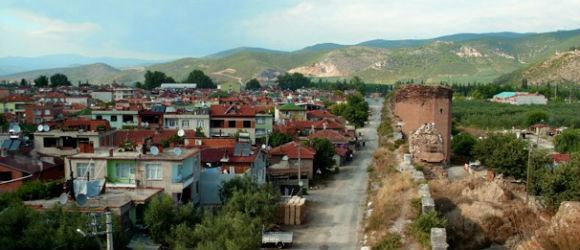Country Turkey Website www.iznik.bel.tr Population 43,425 (2012) Province Bursa Province | Post code 16860 Area 736.5 km² Local time Sunday 3:19 PM | |
 | ||
Weather 19°C, Wind NW at 5 km/h, 46% Humidity Points of interest Hagia Sophia - İznik, Green Mosque, Iznik Museum, Lefke Kapısı, Ayasofya Müzesi | ||
Ancient nicea iznik turkey
İznik is a town and an administrative district in the Province of Bursa, Turkey. It was historically known as Nicaea (Greek: Νίκαια), from which its modern name also derives. The town lies in a fertile basin at the eastern end of Lake İznik, bounded by ranges of hills to the north and south. As the crow flies, the town is only 90 kilometres (56 miles) southeast of Istanbul but by road it is 200 km (124 miles) around the Gulf of Izmit. It is 80 km (50 miles) by road from Bursa.
Contents
- Ancient nicea iznik turkey
- Map of Nicaea C4B0znik2FBursa Turkey
- History
- Pottery and tiles
- Surviving monuments
- Sport
- Twin towns sister cities
- References
Map of Nicaea, %C4%B0znik%2FBursa, Turkey
The town is situated with its west wall rising from the lake itself, providing both protection from siege from that direction, as well as a source of supplies which would be difficult to cut off. The lake is large enough that it cannot be blockaded from the land easily, and the city was large enough to make any attempt to reach the harbour from shore-based siege weapons very difficult.
The city was surrounded on all sides by 5 km (3 mi) of walls about 10 m (33 ft) high. These were in turn surrounded by a double ditch on the land portions, and also included over 100 towers in various locations. Large gates on the three landbound sides of the walls provided the only entrance to the city.
Today the walls are pierced in many places for roads, but much of the early work survives and as a result it is a tourist destination. The town has a population of about 15,000. It has been a district center of Bursa Province since 1930. It was in the district of Kocaeli between 1923 and 1927 and was a township of Yenişehir (bound to Bilecik before 1926) district between 1927 and 1930.
The town was an important producer of highly decorated fritware vessels and tiles in the 16th and 17th centuries.
History
For the history before the Ottoman conquest, see the article on Nicaea.In 1331, Orhan I captured the city from the Byzantines and for a short period the town became the capital of the expanding Ottoman emirate. The large church of Hagia Sophia in the centre of the town was converted into a mosque and became known as the Orhan Mosque. A madrasa and baths were built nearby. In 1334 Orhan built a mosque and an imaret (soup kitchen) just outside the Yenisehir gate (Yenişeh Kapısı) on the south side of the town.
The Moroccan traveller Ibn Battuta stayed in Iznik at the end of 1331 soon after the capture of the town by Orhan. According to Ibn Battuta, the town was in ruins and only inhabited by a small number of people who were in the service of the sultan. Within the city walls were gardens and cultivated plots with each house surrounded by an orchard. The town produced fruit, walnuts, chestnuts and large sweet grapes.
A census in 1520 recorded 379 Muslim and 23 Christian households while a census taken a century later in 1624 recorded 351 Muslim and 10 Christian households. Assuming five members for each household, these figures suggest that the population was around 2,000. Various estimates in the 18th and 19th centuries give similar numbers. The town was poor and the population small even when the ceramic production was at its peak during the second half of the 16th century.
The Byzantine city is estimated to have had a population of 20,000–30,000 but in the Ottoman period the town was never prosperous and occupied only a small fraction of the walled area. A succession of visitors described the town in unflattering terms. After his visit in 1779, the Italian archaeologist Domenico Sestini wrote that Iznik was nothing but an abandoned town with no life, no noise and no movement. In 1797 James Dallaway described Iznik as "a wretched village of long lanes and mud walls...". Most of the remainder of the town was destroyed during 1921 in the Greco-Turkish War (1919–1922); the population became refugees and many historical buildings were damaged or destroyed.
Pottery and tiles
The town became a major center with the creation of a local faïence pottery-making industry during the Ottoman period in the 16th century, known as the İznik Çini. Iznik ceramic tiles were used to decorate many of the mosques in Istanbul designed by Mimar Sinan. However, this industry declined in the 17th century and İznik became a mainly agricultural minor town in the area when a major railway bypassed it in the 19th century. Currently the style of pottery referred to as the İznik Çini is to some extent produced locally, but mainly in Kütahya, where the quality – which was in decline – has been restored to its former glory.
Surviving monuments
A number of monuments were erected by the Ottomans in the period between the conquest in 1331 and 1402 when the town was sacked by Timur. Among those that have survived are:
Several monuments survived into the 20th century but were destroyed during the Greco-Turkish War (1919–1922). These include:
Sport
The İznik Ultramarathon is a 130 km (81 mi) trail endurance running event that takes place around Lake İznik in April since 2012 as the country's longest single-stage athletics competition.
Twin towns – sister cities
İznik is twinned with:
Spandau / Berlin, Germany
